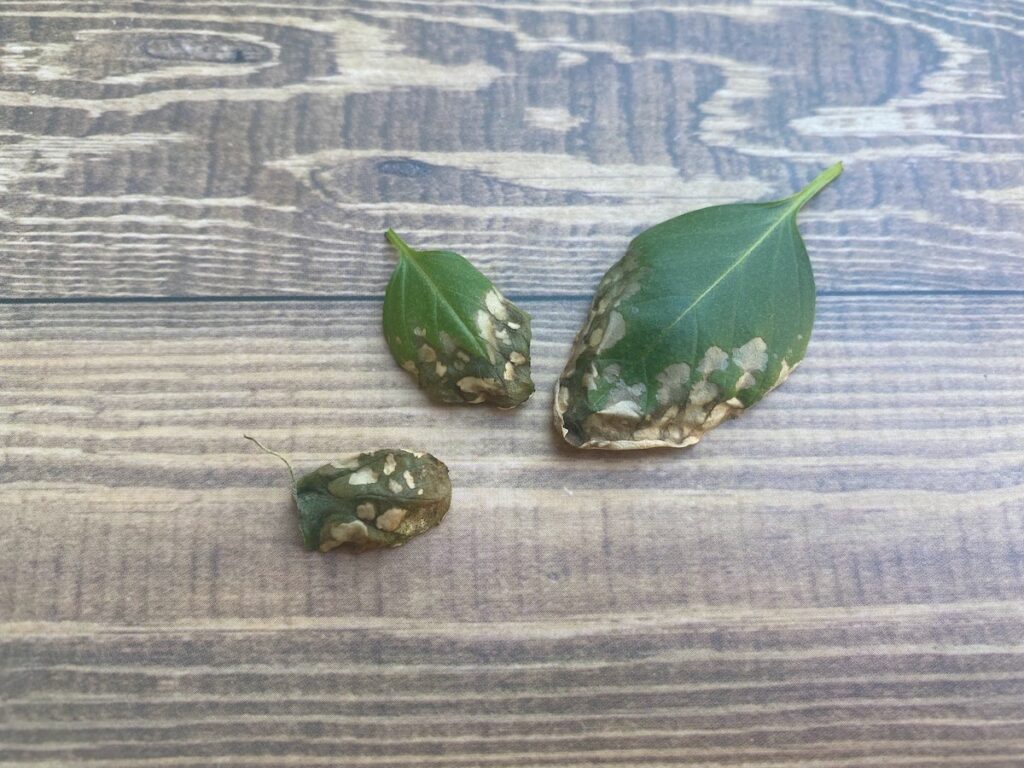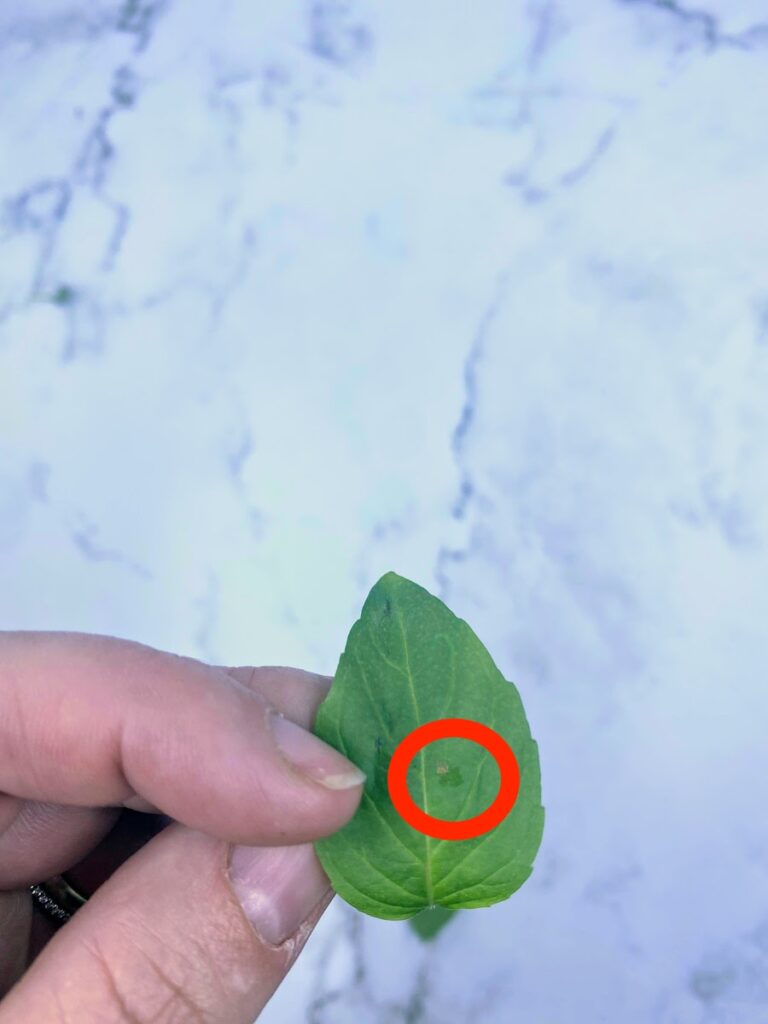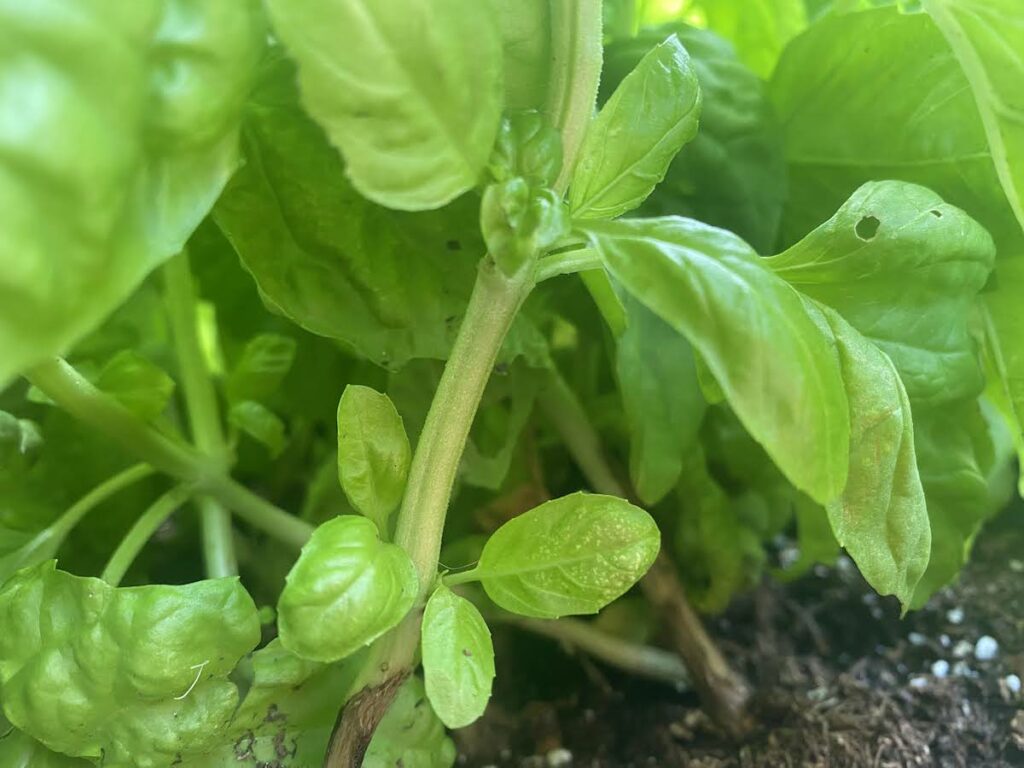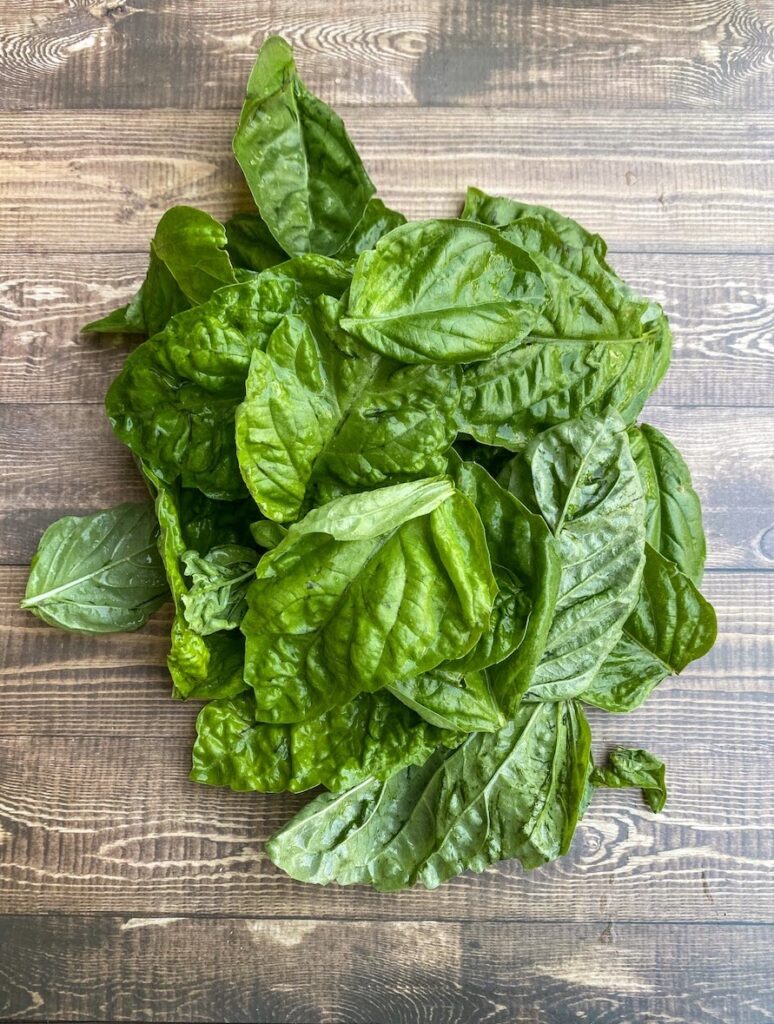As an Amazon Associate I earn from qualifying purchases. This website also participates in other affiliate programs and may earn commissions if you shop through the links used on this website.
(This article was originally published on September 15, 2021 and was last updated on September 15, 2022)
Basil Gardeners Expert Guide to Brown Spots on Basil I How to Treat and Prevent Brown and Black Spots of Basil (+ Can You Eat Spotted Basil Leaves?)
Whether you’ve been growing basil for years or this is your first plant, nothing is more frustrating than heading into your garden (or out onto your patio herb garden) with your pruning shears to clip some basil for your kitchen, and finding brown spots on basil leaves.

Chances are, you’ve been here – I know I certainly have!
And while basil brown spots are certainly frustrating, they’re rarely completely devastating to your plant, and can often be treated fairly easily, so you can get back to picking gorgeous, healthy basil leaves for your meals!
More Than 7,000 People Can’t Be Wrong!
For one-off problems with your basil or herb garden, a quick Google to solve the problem is great.
But if you want more help getting the herb garden of your dreams, mastering cooking with basil, or other creative uses of basil, Skillshare has some awesome herb-related courses (plus a ton of other interesting, useful and cool courses).
To date, more than 7,000 students have taken Indoor Gardening: Grow Houseplants, Veggies, and Herbs!
Normally Skillshare Gives A 7-Day Free Trial. You Get A 30-Day Free Trial (OR 30% Off An Annual Membership)
Our friends at Skillshare have graciously offered our readers an extended free trial, using this link here to sign up. Instead of 1 week to try out all their courses, you get a full month to try courses like:
- Indoor Gardening: Grow Houseplants, Veggies, and Herbs // (use this link to get a 30-day Free trial) // (use this link to 30% off an Annual Membership)
- Create a Small Space Edible Garden // (use this link to get a 30-day Free trial) // (use this link to 30% off an Annual Membership)
- 5 Easy to grow herbs, sowing, growing and harvesting // (use this link to get a 30-day Free trial) // (use this link to 30% off an Annual Membership)
- Crafting Infused Tea: Herb, Flower, and Fruit Iced Teas // (use this link to get a 30-day Free trial) // (use this link to 30% off an Annual Membership)
Sign up for a FREE 30-Day Trial (this link only)
Or Save 30% Off An Annual Skillshare Membership
If you know you’re going to love Skillshare, you can also sign up for an annual membership and save 30% with this link.
What Causes Brown Spots on Basil?
Frequently, brown spots on basil (along with basil leaves that are turning black, and white stuff on your basil) are a result of bacterial or fungal infections. Other possible causes include pests eating holes in your basil or a poor soil nutrient profile.

Top 5 Causes of Brown Spots on Basil
Below, you’ll find some of the most common causes of this basil ailment, along with my suggestions about how to treat (and, more importantly) prevent them!

Fusarium Wilt
Fusarium wilt is a common but devastating basil disease caused by the fungus Fusarium oxysporum.
In addition to being common and fairly devastating to the plant, it’s also a notoriously difficult problem to treat. Once soil becomes infected, the infection can last for years. Likewise, the surface of infected basil plants can infect nearby plants, making it important to remove infected plants quickly.
Fusarium wilt is most often introduced by infected seeds. As such, when growing basil from seed, only buy seeds from a reputable seller that have been tested for the fungus. If you’re growing basil from cuttings, make sure the mother plant isn’t infected by using a mature plant that hasn’t exhibited any symptoms of the disease, since it doesn’t typically show up until plants are between 6″ and 12″ tall. And while this should go without saying, don’t collect seeds from an infected plant to use in future years – you’ll just create more misery for you and your basil crop.
Additionally, know the signs and what to look for to identify an infected plant. The sooner you can identify fusarium wilt and remove the plant, the better you’ll be able to control the infection, preventing it from spreading.
Basil plants infected with Fusarium oxysporum present the following symptoms:
- Appear to grow like normal, healthy basil plants until they get to between 6″ and 12″ tall, at which point symptoms appear.
- Dark, brown streaks and spots along the stems of the basil plants.
- Wilted leaves, generally indicating plant distress.
- Brown spots or brown patches on the basil plant’s leaves
- Leaf death, whereby previously green leaves turn brown and black
Fungal Leaf Spot
Another fungal disease, fungal leaf spots are are caused by the colletotrichum fungus. Thankfully, this fungus tend to be more localized and less devastating than fusarium wilt.
Look for round brown spots on the basil leaves, that dry out and disintegrate, causing that part of the leaf to drop out. This leaves full basil leaves with holes in them, as if they were drilled through or shot.

If the infection is severe, fungal leaf spot can affect all of the leaves and lead to plant death.
However, there’s a wide range of damage between a single or several leaf spots and plant death, and typically this fungus causes more mild issues for a basil plant.
Fungal leaf spot thrives in moist, humid environments. Likewise, wet leaves or foliage contributes to further growth of the fungus. When its spores get into water, this allows it to spread further afield, to nearby plants.
To ensure infections remain localized and don’t grow too much, make sure the plants have enough space between them, ensure some air can circulate, and make sure they have enough direct sunlight each day. Remove dead foliage from the plant and soil surface, and don’t overwater your basil (for many reasons – it can also turn all the leaves from gorgeous green to a sad yellow color).
If you identify an infected plant, remove it so it isn’t around other plants and can’t spread. Prune any stems that are infected as soon as possible, too.
Downy Mildew
Telltale signs of downy mildew include yellowing or browning of the basil leaves, starting in the veins and moving out to the entire leaf, with a fuzzy, powder like grey substance on the leaf undersides.
Again, this one is caused by infected seeds, but can go on to affect the entire plant.
Downy mildew can be controlled by maintaining good planting and growing conditions. As with the diseases above, space out each basil plant when planting or potting.
Likewise, adopt good watering habits by watering your plants close to the roots to keep the leaves and stems dry, rather than watering from overhead.
Finally, try to treat the plant quickly by removing leaves that show signs of a downy mildew infection.
While not fatal, it can be an annoying disease to treat. Once the leaves start to turn yellow or brown, remove them promptly!
Cercospora Leaf Spot
This is another fungal infection, and like some of the others, is related to overhead watering or misting the leaves, which leaves water beads on the leaves, and leaves too much moisture on the plant.
Moist leaves creates an ideal environment for fungal infections, so your best bet is to water the soil near the base of the stem and keep the leaves as dry as possible.
If you do notice fungal spores on the leaves, you can wash the leaves and wipe the spores away. However, you want to make sure the leaves dry out fairly quickly, and don’t want them to be saturated with water for an extended period.
If you spot leaves with leaf spot, prune and get rid of the leaves that are infected. Look for dark, brownish-black spots with uneven borders, and a lighter brown center.
This disease can spread through wind, water, and contaminated soil, so proper watering habits, spacing out your plants, and quick identification and removal of infected leaves can help control it.
Bacterial Leaf Spot / Pseudomonas Cichorii
If you notice brown or black spots on your leaves that then dry out and become holes in the leaves, you might have bacterial leaf spot, caused by Pseudomonas Cichorii. This infection can also include brownish streaks on the stems.
Bacterial Leaf Spot needs the right conditions to thrive and infect your basil plants. And one of the main conditions it looks for is an over abundance of nitrogen in the soil.
Most often, too much nitrogen is caused by too much fertilization. While you can fertilize basil plants, it doesn’t need as much as other plants, and generally I tend to be fairly lazy about fertilizing my basil!
As with the fungal diseases listed above, this bacterial infection also thrives in moist conditions, so you want to avoid overhead watering and soaking the leaves (rather than the soil and stems) of the plant.
As soon as you notice infected leaves, remove them so the bacteria doesn’t spread via water splashes, rain, and runoff.
How to Prevent Brown Spots on Basil
Once you notice brown spots on basil, the best thing to do is act quickly and remove the infected leaves. However, it’s also worth putting in some thought about how to prevent them from occurring in the first place.
Safe Seeds
Ensure you buy your plants from reputable sellers, and that the seeds have been tested to ensure they’re free of disease. As an annual plant, the basil growing season is short enough as it is – you want to maximize your harvest with healthy seeds, and not race against the clock of Father frost and winter!
Proper Watering Habits
Unfortunately, many of these diseases can be spread or exasperated by unsanitary gardening practices.
Most notably, watering the basil plants from overhead, which soaks the leaves with water, is a no-no.
This can spread diseases that are spread through water (i.e. bacterial leaf spot, basil downy mildew), and increases the likelihood of the leaves succumbing to a bacterial or fungal infection, since they’re moist, waterlogged, and generally not living their best life.
Adequate Plant Spacing
If you’re growing multiple basil plants, or indeed multiple plants at all, make sure you give them enough space between each. This also means ensuring plants have large enough pots if you plant multiple basil plants in a single pot. This will reduce the chance that infections can transfer between plants with splashes of water or gusts of wind. However, it will also ensure the plant has enough airflow around it, so it doesn’t become too moist, particularly on the leaves, which is ideal growing condition for bacteria and fungus.
Quick Action
If you notice brown or black spots on basil plants, take quick action to remove the infected leaves, and carefully inspect the plant for other possible signs of trouble. Regularly trimming and harvesting your basil is essential to healthy plant growth – this includes both healthy leaves and getting rid of unhealthy ones.
Most of the time, this action alone will be enough to prevent the problem from growing.
Generally speaking, I don’t recommend fungicides and bactericides, unless they’re suitable for edible produce.
Growing Indoors
While it’s not a guarantee, growing a basil plant indoors instead of outdoors will reduce the chances of your plant being infected by some of these issues.
My lemon basil pictured below has brown spots along the edges – my theory is this is from either sunburn, or because I was too aggressive about rubbing my fingers on the tender seedlings at the beginning. Whoops!

Can You Eat Brown Basil Leaves?
Generally, speaking, I don’t recommend eating basil leaves that have any signs of disease or infection.
Here’s why. In the grand scheme of things, it’s probably fine to eat basil leaves that have brown spots. However, you need to be sure to inspect the leaves first for signs of disease, such as fungus, bacteria, spores or mildew.
Since it’s difficult to be sure what exactly is causing the brown spots, and since healthy basil is affordable and abundant, I prefer not to eat basil with brown spots.

While you may assume it’s a bacterial or fungal infection, it’s also possible it was caused by a pest, eating holes in your basil leaves. If that’s the case, pests can leave behind feces and eggs on the leaves which isn’t the most appetizing concept in my view.
Likewise, stressed leaves won’t be the most delicious leaves. Just as a plants energy goes into producing seeds once it flowers, leaving the leaves more bitter and less delicious, an infected plant focuses it’s energy on healing. If the plant is stressed, it’s energy will go into dealing with the infection, rather than producing the oils that make basil so fragrant and delicious. This reduced flavor profile, combined with the risk of accidentally consuming bacteria, fungus, or pest eggs or feces, makes it simply not worth it to me!
Final Thoughts About Dealing with Brown Spots on Basil Leaves
I hope this article helps you identify and treat the cause of your brown spots on basil, so you can get back to making delicious recipes with your basil soon!
